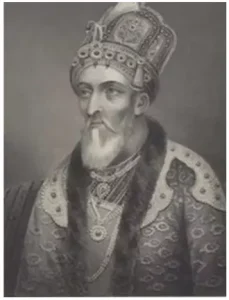Bahadur Shah Zafar was the last Mughal emperor of India, ruling from 1837 until the British took full control. He played a symbolic role in the 1857 revolt against British rule, though his influence was limited. Exiled to Rangoon after the rebellion, Zafar died in 1862. Known for his poetry, Zafar remains a significant figure in India's history and a symbol of resistance.

Bahadur Shah Zafar was the last Mughal emperor of India, ruling from 1837 until the British took full control. Ideally, He was known for his poetry and literary contributions; also, Zafar played a symbolic role in the 1857 revolt against British rule.
Despite limited political power, he became the face of India’s struggle for independence as he participated actively in this. Here, we will provide complete details about his life, contributions, exile in Rangoon, and legacy as the final Mughal ruler.
Bahadur Shah Zafar was born on October 24, 1775, and was the last Mughal emperor of India i.e, religion – Sunni Islam). He ruled from 1837, i.e, (18th & 19th centuries), but by then, the Mughal Empire had already lost most of its power.
The British East India Company had control over most of India, and Zafar was left with limited authority in the region. Even though he did not have much political control, Zafar became famous for his poetry and later for his involvement in the 1857 rebellion against the British.

Bahadur Shah Zafar’s full name was (Mirza Abu Zafar Siraj-ud-Din Muhammad Bahadur Shah). He was the spouse of Zeenat Mahal and the second son of Lal Bai and Akbar Shah II, who died in 1837, and came from a long line of Mughal rulers, but by the time he became emperor, the Mughal Empire was barely a shadow of its former self, as it had already declined in every aspect.
But poetry (also famous for his Urdu writings) and his other work make him a known Mughal ruler. The court he established became a place for many famous Urdu scholars, poets, and writers, such as Mirza Ghalib, Daagh Dehlvi, Momin Khan Momin, and Mohammad Ibrahim Zauq, who was also the mentor of Bahadur Shah Zafar.
Bahadur Shah Zafar was known for his love of literature and poetry. He wrote under the pen name “Zafar” and was famous for his work, i.e, also for his Urdu writings. Though his empire had been destroyed, Zafar remained respected by many for his wisdom and charm that he showed to everyone.
His rule was mostly symbolic, and the British controlled most of India during his time as emperor because he was not into all these alliances and strategies. Despite this, he continued to support the arts and was seen as a poetic ruler.
In 1857, when the First War of Indian Independence broke out, Bahadur Shah Zafar became the figurehead for the rebellion against the British as he actively participated in this. Even though he had little experience in military strategy, people turned to him for leadership.
He declared himself the leader of the revolt, even though his role was largely symbolic in this. The British forces soon crushed the rebellion, and Zafar was captured by them. However, his involvement made him an important symbol of India’s struggle for freedom and justice.
After Zafar’s defeat, he said:
As long as there remains the scent of faith in the hearts of our Ghazis,
so long shall the sword of Hindustan flash before the throne of London.
After the British ended the revolt, Bahadur Shah Zafar was arrested and sentenced to exile in Rangoon, Burma (now Yangon, Myanmar).
His time in Rangoon was a sad end to his once-glorious life and charm. He was kept in a small, cold jail, far from his family and the empire he once ruled with so much warth and respect. Despite being in exile, He continued to write poetry because he was very interested in poetry and all the artwork. At that time, he expressed his sadness and the pain of his downfall.
Check Out UPSC CSE Books
Visit PW Store
Bahadur Shah Zafar passed away on November 21, 1862, in Rangoon at the age of 87. His death marked the official end of the Mughal dynasty that had ruled India for centuries in Indai and many parts. Zafar died a broken man, far from his homeland, with little recognition for his symbolic role in the 1857 revolt.
Bahadur Shah Zafar’s tomb is located in Rangoon, Burma (Myanmar). It is a simple and modest structure, a stark contrast to the grandeur of his once mighty empire.
His tomb remains a place of pilgrimage for many Indians who remember him as a symbol of resistance and as the last Mughal emperor. Even in exile, Zafar’s legacy continues to inspire those who remember the bravery shown during the 1857 revolt.
Ready to boost your UPSC 2026 preparation? Join PW’s UPSC online courses today!
Bahadur Shah Zafar was the last Mughal emperor of India, ruling from 1837 i.e, (18th & 19th centuries) until the British took control. He is known for his poetry and symbolic role in the 1857 revolt against British rule.
Bahadur Shah Zafar became the face of the 1857 revolt, even though his role was more symbolic. Zafar led the rebellion against the British but was captured when they suppressed the revolt.
After the British defeated the revolt, Bahadur Shah Zafar was exiled to Rangoon (now Yangon, Myanmar), where he lived in harsh conditions until his death.
Bahadur Shah Zafar died on November 21, 1862, in Rangoon at the age of 87, far from his homeland.
Bahadur Shah Zafar is also remembered for his love of literature and poetry. Basically Zafar was a skilled poet.
Bahadur Shah Zafar’s tomb is in Rangoon, Burma (Myanmar), and it remains a place of pilgrimage for many Indians who honor his legacy and his charm.

<div class="new-fform">
</div>